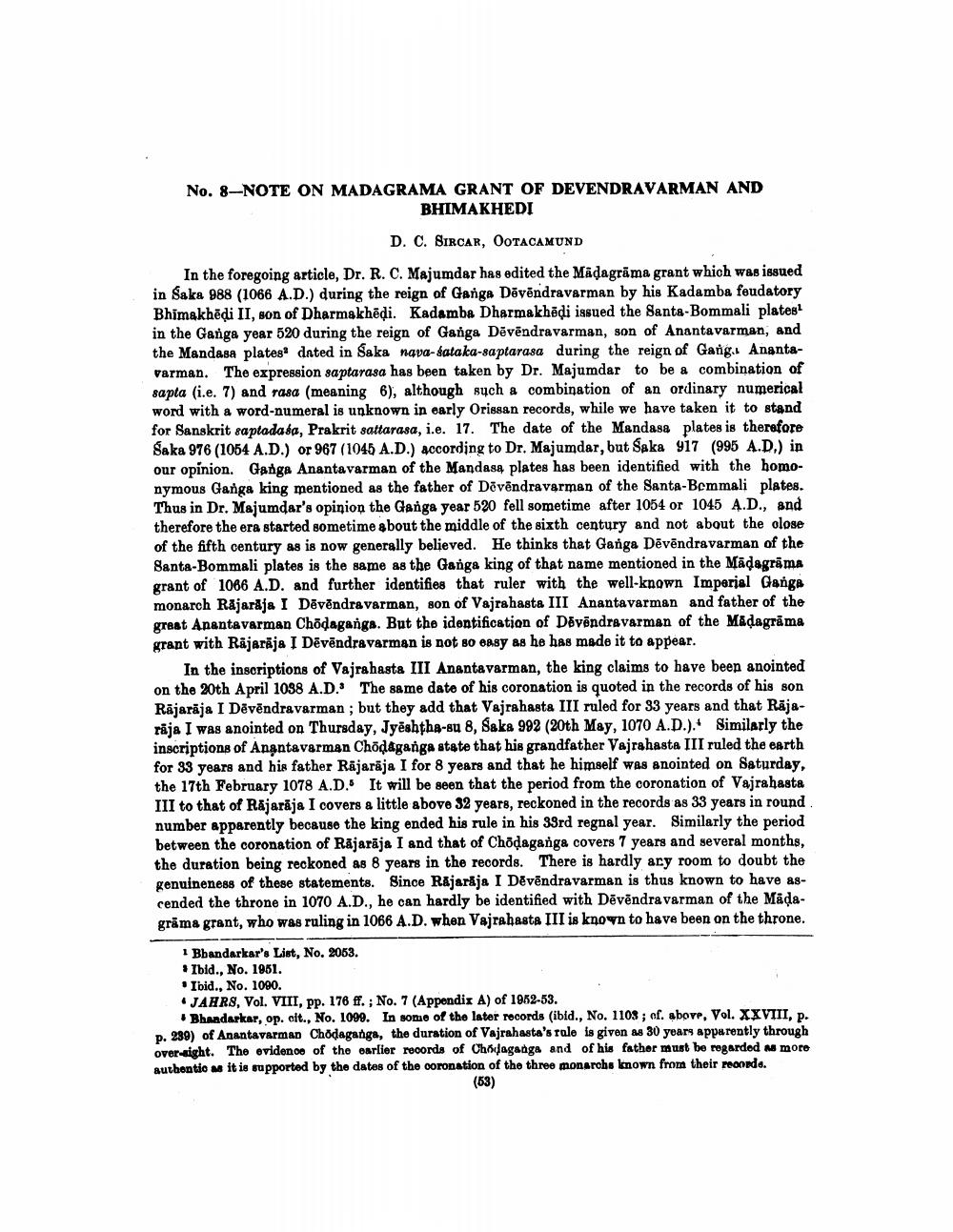________________
No. 8-NOTE ON MADAGRAMA GRANT OF DEVENDRAVARMAN AND
BHIMAKHEDI
D. C. SIRCAR, OOTACAMUND
In the foregoing article, Dr. R. C. Majumdar has edited the Madagrāma grant which was issued in Saka 988 (1066 A.D.) during the reign of Ganga Dāvēndravarman by his Kadamba feudatory Bhimakhēdi II, son of Dharmakhēdi. Kadamba Dharmakhēdi issued the Santa-Bommali plates! in the Ganga year 520 during the reign of Ganga Dēvēndravarman, son of Anantavarman, and the Mandasa plates dated in Saka napa-kataka-saptarasa during the reign of Gang.. Anantavarman. The expression saptarasa has been taken by Dr. Majumdar to be a combination of sapta (i.e. 7) and rasa (meaning 6), although such a combination of an ordinary numerical word with a word-numeral is unknown in early Orissan records, while we have taken it to stand for Sanskrit saptadasa, Prakrit sattarasa, i.e. 17. The date of the Mandasa plates is therefore Saka 976 (1054 A.D.) or 967 (1045 A.D.) According to Dr. Majumdar, but Saka 917 (995 A.D.) in our opinion. Ganga Anantavarman of the Mandase plates has been identified with the homonymous Ganga king mentioned as the father of Dēvēndravarman of the Santa-Bemmali plates. Thus in Dr. Majumdar's opinion the Ganga year 520 fell sometime after 1054 or 1045 A.D., and therefore the era started sometime about the middle of the sixth century and not about the olose of the fifth century as is now generally believed. He thinks that Ganga Dēvēndravarman of the Santa-Bommali plates is the same as the Ganga king of that name mentioned in the Madagrāma grant of 1066 A.D. and further identifies that ruler with the well-known Imperial Ganga monarch Rajaraja I Dēvēndravarman, son of Vajrahasta III Anantavarman and father of the great Anantavarman Chödaganga. But the identification of Dāvēndravarman of the Madagrāma grant with Rajaraja I Dēvēndravarman is not so easy as he has made it to appear.
In the inscriptions of Vajrahasta III Anantavarman, the king claims to have been anointed on the 20th April 1038 A.D. The same date of his coronation is quoted in the records of his son Rajaraja I Dēvēndravarman ; but they add that Vajrahasta III ruled for 33 years and that Rajarāja I was anointed on Thursday, Jyēshtha-su 8, Saka 992 (20th May, 1070 A.D.). Similarly the inscriptions of Anantavarman Chodaganga state that his grandfather Vajrahasta III ruled the earth for 33 years and his father Rajaraja I for 8 years and that he himself was anointed on Saturday, the 17th February 1078 A.D. It will be seen that the period from the coronation of Vajrahasta III to that of Rajaraja I covers a little above 32 years, reckoned in the records as 33 years in round number apparently because the king ended his rule in his 33rd regnal year. Similarly the period between the coronation of Rājarāja I and that of Chodaganga covers 7 years and several months, the duration being reckoned as 8 years in the records. There is hardly ary room to doubt the genuineness of these statements. Since Rajaraja I Dēvēndravarman is thus known to have ascended the throne in 1070 A.D., he can hardly be identified with Dēvēndra varman of the Mädagräma grant, who was ruling in 1066 A.D. when Vajrahasta III is known to have been on the throne.
1 Bhandarkar's List, No. 2053. * Ibid., No. 1951. • Ibid., No. 1090. • JAHRS, Vol. VIII, pp. 176 ff.; No. 7 (Appendix A) of 1962-53.
Bhandarkar, op. cit., No. 1099. In some of the later records (ibid., No. 1103 ; of. above, Vol. XXVIII, P. p. 289) of Anantavarman Chodaganga, the duration of Vajrahasta's rale is given as 30 years apparently through over-sight. The evidence of the earlier records of Chodaganga and of his father must be regarded na more authention it is supported by the dates of the coronation of the three monarchs known from their reoorde.
(53)




